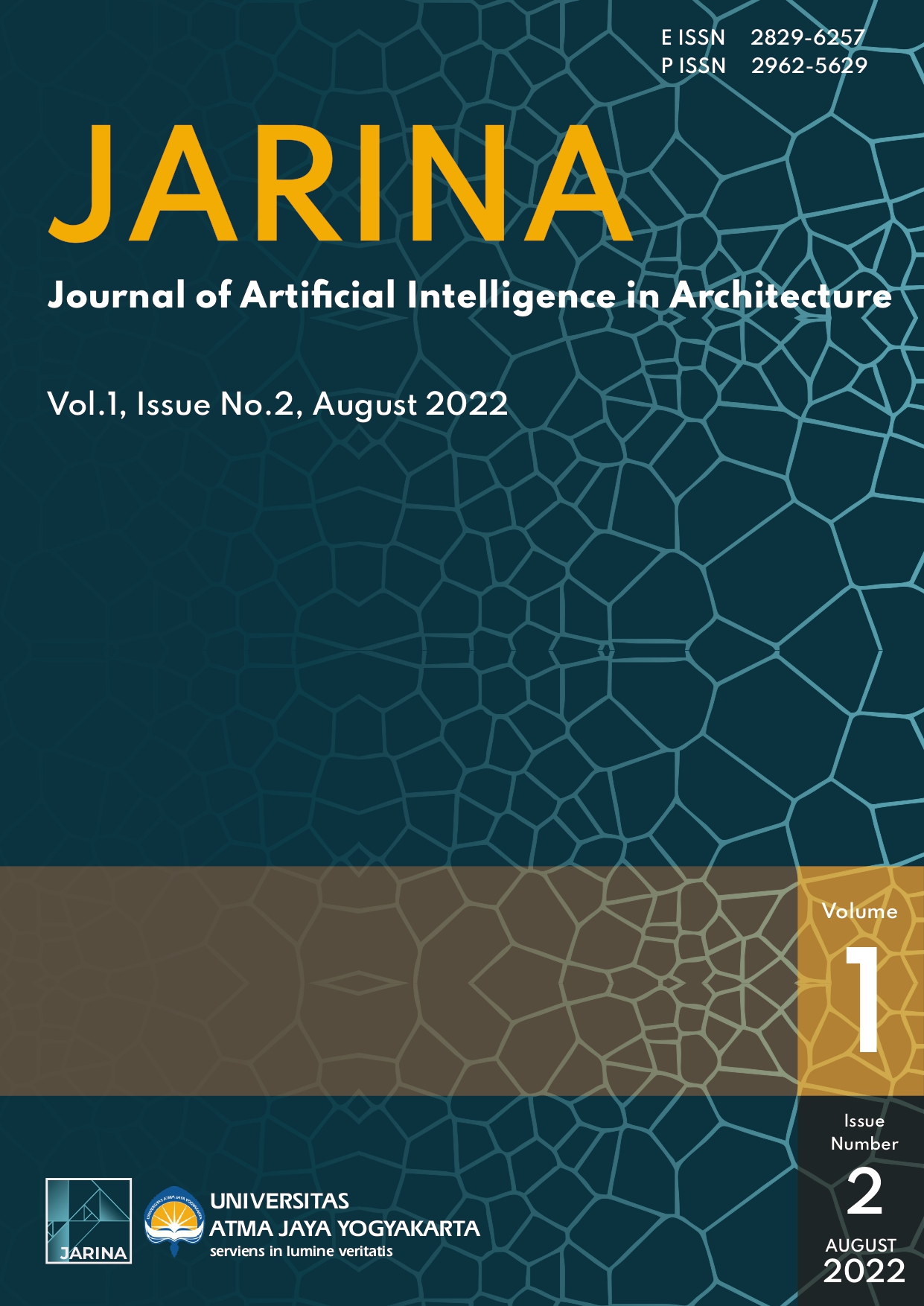Application of Artificial Intelligence in Digital Architecture to Identify Traditional Javanese Buildings
DOI:
https://doi.org/10.24002/jarina.v1i1.4916Keywords:
Digital Architecture, Artificial Intelligence, Javanese Traditional Building, Support Vector Machine, Convolutional Neural NetworkAbstract
Traditional buildings have a cultural philosophy and characterize the culture of an area. The occurrence of environmental changes, population growth, and the growth of modern buildings impact traditional buildings. Therefore, preserving those traditional buildings is needed to avoid extinction and make as cultural assets. The research aims to develop an application to help architects quantitatively measure the content of traditional architectural styles in their designs. This study uses the Artificial Intelligence (AI) method to identify buildings' similarities, acquiring traditional building data in roofs and ornaments images as a dataset totaling 650 images of roofs and 7,180 ornaments. Data processing was carried out by making architectural models, training, testing accuracy, and creating application interfaces. The algorithm used to identify similarities between building types was the Convolutional Naural Network (CNN) and the Support Vector Machine (SVM). The results of the accuracy-test using the Confusion matrix method reached an accuracy value of 99.5% in identifying building similarities and 85% in classifying building types.
References
M. Glaser and S. Schwan, "Processing textual and visual certainty information about digital," Computers in Human Behavior, vol. 96, pp. 141-148, 2019.
F. Fontanella, F. Colace, M. Molinara, A. S. Di Freca and F. Stanco, "Pattern Recognition and Artificial Intelligence Techniques for Cultural Heritage," Pattern Recognition Letters, no. punlish elsavier, 2020.
S. Soliman, D. Taha and Z. El Sayad, "Architectural education in the digital age," Alexandria Engineering Journal, vol. 58, pp. 809-818, 2019.
I-JuiLee, C. HsuChen and K. PingChang, "Augmented reality technology combined with three-dimensional holography to train the mental rotation ability of older adults," Computer in Human Behavior, vol. 65, pp. 488-500, 2016.
P. M. Bosch-Sijtsema and J. Haapamäki, "Perceived enablers of 3D virtual environments for virtual team learning and innovation," Computer in Human Behavior, vol. 37, pp. 395-401, 2014.
Glaser, M., and Schwan, S, "Explaining pictures: How verbal cues influence processing of pictorial learning material.," Journal of Educational Psychology, vol. 107(4), p. 1006–1018., 2015.
M. Glaser and S. Schwan, "Processing textual and visual certainty information about digital architectural models," Computer in Human Behavior, vol. 96, pp. 141-148, 2019.
L. Yong, Z. Mingmin, J. Yunliang and Z. Haiying, "Improving procedural modeling with semantics in digital architectural heritage," Computers & Graphics, vol. 36, pp. 178-184, 2012.
M. Turker and D. K. San, "Building extraction from high-resolution optical spaceborne images," International Journal of Applied Earth Observation and, vol. 34, pp. 58-69, 2015.
N. A. Utami, W. Maharani and I. Atastina, "Personality Classification of Facebook Users According to Big FivePersonality Using SVM (Support Vector Machine) MethodNinda Anggoro Utamia, Warih Maharania,∗, Imelda AtastinaaaSchool of Computing, Telkom University, Bandung, Indonesia, 40257AbstractSocia," in 5th International Conference on Computer Science and Computational Intelligence 2020, Bandung-Indonesia, 2020.
Q. L. Khan, Q. H. Thai, E. K. YeeYapp, O. Y. Yen and Y. Yuan, "DeepETC: A deep convolutional neural network architecture for investigating and classifying electron transport chain's complexes," Neurocomputing, vol. 375, pp. 71-79, 2020.
N. Q. Khanh Le, Q. Thai Ho and Y. Yen Ou, "Incorporating deep learning with convolutional neural networks and position specific scoring matrices for identifying electron transport proteins," Computational Chemistry, 2017.
S. Winiarti, Murinto, D. I. Pramudi and A. Prahara, "Pre-Trained Convolutional Neural Network for," (IJACSA) International Journal of Advanced Computer Science and Applications, vol. 9, pp. 212-217, 2018.
K. Suyanto, N. Ramadhani and S. Mandala, Deeplearning Modernisasi Machine Learning untuk Big Data, Bandung-Indonesia: Informatika Bandung, 2019.
A. Krizhevsky, I. Sutskever and G. E. Hinton, "ImageNet classification with deep convolutional neural networks," in the 25th International Conference on Neural Information Processing Systems, 2012.
C. CHUNG CHANG and C. JEN LIN, "LIBSVM: A Library for Support Vector Machines," ACM Trans. Intell. Syst., vol. 2, no. 3, pp. 1-27, 2011.
A. Javier Gallego, A. Pertusa and J. C. Zaragoza, "Improving Convolutional Neural Networks’ Accuracy," Aplied Sciences, 2018.
J. D. Novakovic, A. Veljovic, S. S. Ilic, Z. Papic and M. Tomovic, "Evaluation of Classification Models in Machine Learning," Theory and Applications of Mathematics & Computer Science, vol. 7, pp. 39-46, 2017.
D. Ivo and G. Gediga, "Confusion Matrices and Rough Set Data Analysis," in IOP Conf. Series: Journal of Physics: Conf. Series 1229 (2019) 012055, 2019.
Published
How to Cite
Issue
Section
License
Copyright (c) 2022 Sri Winiarti, Heri Pramono, Andri Pranolo

This work is licensed under a Creative Commons Attribution 4.0 International License.
Authors who publish with this journal agree to the following terms:
1.Authors retain copyright and grant the journal right of first publication with the work simultaneously licensed under a Creative Commons that allows others to share the work with an acknowledgement of the work's authorship and initial publication in this journal.
2.Authors are able to enter into separate, additional contractual arrangements for the non-exclusive distribution of the journal's published version of the work (e.g., post it to an institutional repository or publish it in a book), with an acknowledgement of its initial publication in this journal.
3.Authors are permitted and encouraged to post their work online (e.g., in institutional repositories or on their website) prior to and during the submission process, as it can lead to productive exchanges, as well as earlier and greater citation of published work (See The Effect of Open Access).

















